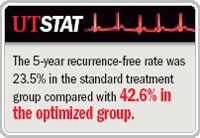Article
Survival benefit follows four-point bladder cancer protocol
Author(s):
Atlanta-How many significant clinical advances began like this?

"I was having a cup of coffee with a urologist, and I asked him how I might help solve problems with bladder cancer. He said he had this treatment for bladder cancer and, depending on who gives it, it was sometimes very effective and sometimes ineffective."
Jessie L-S Au, PharmD, PhD, distinguished university professor in the College of Pharmacy, Ohio State University, Columbus, smiles as she recounts the origin of this study to Urology Times.

Optimized intravesical therapy is a four-legged stool. Each leg is necessary to success. The four fundamental aspects of the therapy are giving the correct dose, patient compliance with dehydration instructions, urine alkalinization, and ensuring maximal dehydration before instillation of therapy.
Standard vs. optimized Tx
The phase III, multi-institutional, prospective trial, begun in the 1990s, placed 230 patients with transitional cell carcinoma at high risk of recurrence into standard treatment or optimized treatment arms. Those in the standard arm received mitomycin C (MMC [Mutamycin]), 20 mg in 20 mL sterile water, without pharmacologic manipulation or urine alkalinization.
Patients designated for optimal treatment were given MMC, 40 mg in 20 mL sterile water, and were instructed to drink no fluids 8 hours before the procedure. Sodium bicarbonate, 1.3 grams, was administered the night before instillation, with additional bicarbonate given in the morning of instillation and still more 30 minutes before instillation. Patients' bladders were emptied with a Foley catheter before instillation, and ultrasound was used to alter the location of the catheter to insure that residual urine volume did not exceed 10 mL. The dosing solution of MCC was 40 mg/20 mL for 2 hours. Patients in both arms received six weekly treatments.
Dr. Au's data showed that the time to recurrence increased from 11.3 months for patients in the standard treatment arm to 29.1 months for those in the optimized arm. The 5-year recurrence-free rate was 23.5% in the standard treatment group compared with 42.6% in the optimized group.
Median follow-up in the initial study in 2001 was 11.7 months. Follow-up for the data presented at the AUA meeting showed the improvements continue to hold to an average of 48.4 months. Both findings were significant (p=.0001).
"A lot of clinicians were thinking that it was just the increased dose of mitomycin alone that made the difference," Dr. Au told Urology Times. "It is not just the dose. We don't have the data here, but a parallel study shows that just increasing the dose is not sufficient; the bladder empyting, dehydration, and Tums (alkalinization) are important. Without those, you do not get the benefit."
Subgroup results confirm therapy
Subgroup analysis of the current data showed that the optimized therapy produced benefits across a host of subgroups to include patients with multifocal, unifocal, Ta (submucosal), papillary, recurrent, primary, and low-grade cancers, and those who had undergone previous treatments. A trend toward improvement in patients with T1 (p=.06), Tis (p=.3) and high-grade cancer (p=.09) also was seen.
Newsletter
Stay current with the latest urology news and practice-changing insights — sign up now for the essential updates every urologist needs.





